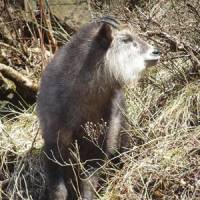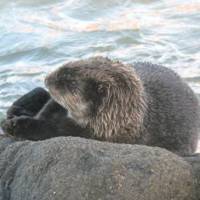I came across my first bumblebees of the season as they were busily draining the nectar from a broad swath of Blue Corydalis. The delicate flower stems nodding in a light breeze looked delightful in the sunshine, while above them frothy willow catkins were yellow with pollen and here and there birches were presenting hints of fresh green.
Then an iridescent Japanese Fiddle Beetle scurried across my path before several Peacock Butterflies and a gorgeous Blue Admiral Butterfly fluttered by, seeming to daub splashes of vibrant color on the leaf-litter wherever they landed.
Next, I spotted an Eastern Crowned Warbler flitting through the birches — a newly arrived migrant from the south that seemed more to squeeze out, rather than sing, its compressed, buzzing spring refrain: "Peetsu peetsu bzee."
Sunshine and a brief spell of warmth after recent rain and weeks of cold since winter ended had tempted them all forth — and me, too. As I tramped the trails of Nopporo Forest Park in Sapporo seeking new signs of spring, what struck me most were the fresh signs of aliens afoot.
For starters, in the soft muddy sand of a streambed I came across a trail of long-fingered and long-toed prints indicating the recent passage of a Northern Raccoon.
Introduced to Japan during the late 1970s, raccoons have spread, causing havoc both for native environments and agriculture. Along with the likes of the Taiwan Macaque, Pallas' Squirrel and American Mink, they are one of several relatively recent perturbations in the diversity of Japan's mammal fauna.
However, diversity in adversity and isolation define both the fauna and flora of Japan. Its geological history, shaped by major subterranean forces as it rides the confluence of four tectonic plates, means that the archipelago has had a very chequered history that has given it an extraordinarily diverse natural history and an impressive suite of mammals — thankfully, most of them not alien.
In fact, more than 130 nonmarine (i.e. terrestrial, arboreal and flying species) and 40-plus marine mammal species are known from Japan, though it's not the numbers that are impressive but the different types of such animals that occur here.
Among these 170 or so species, for instance, there are a number of wide-ranging Holarctic species, such as the Red Fox and Brown Bear, in common with both North America and the great span of northern Eurasia. There are Palaearctic species too, such as the Eurasian Red Squirrel and Siberian Flying Squirrel, which range across Eurasia from Scandinavia to Hokkaido. Between them, these two groups lend an air of familiarity to Japan's mammal fauna for European and American visitors.
Then there are the East Asian species, which are known from Japan and adjacent areas of the Asian continent, such as the Tanuki (Raccoon Dog) and the Sika Deer, which would be equally familiar to residents of northeast China, the Korean Peninsula, or eastern Russia.
But it is in the diversity of its more than 40 endemic species that Japan shows its true colors. These are species known only from Japan and nowhere else. Some range widely throughout several of the main Japanese islands, such as the Japanese Macaque, Japanese Hare and Japanese Giant Flying Squirrel; others occur only in small, isolated localities — and some only on small islands, such as the endemic Amami Black Rabbit.
Offshore, Japanese waters are also rich in marine mammal species. Seals, fur seals, sea lions, sea otters, dugong, dolphins, porpoises and whales range in their preferred habitats from the subtropical waters off the southernmost islands and the warm seas around southern Japan, to the cold current flowing south down the Pacific coast and the frigid waters of the Okhotsk Sea bordering Hokkaido.
Sadly, past human activity has already driven several species from Japan to extinction, including the River Otter and Japanese Wolf. Additionally, the more recent introduction of a number of "alien" species, such as Pallas' Squirrel and the Northern Raccoon, may well lead eventually to further losses of native or even endemic species.
The fauna of an island group is constantly in flux, shifting and changing naturally over immensely long periods of time, whereas human-induced perturbations happen very quickly and cause considerable disruption. How is it, though, that Japan has such a wide range of ingredients in its mammal species "cake"?
At times the Japanese islands have been connected to the Asian continent, with the Sea of Japan a mere inland lagoon, and connections northward via what is now Sakhalin to northeast Asia and southward via what are now the Korean Peninsula and the island of Taiwan.
Through complex processes, involving both tectonic movements and the planet's pendulum swing between glacial and interglacial periods, at times sea levels have risen and caused the isolation of parts of the archipelago as long ranges of mountains, or even as isolated mountain-top islands (the Nansei Shoto today), where species have evolved in isolation.
At other times, the same processes have caused sea levels to fall, reconnecting long-isolated lands to each other and sometimes to the nearby continent via land bridges across which continental mammals have been able to immigrate and expand their ranges, hence allowing the populations of species in once-isolated areas to meet and mix once more.
From Kyushu to Hokkaido, the Japanese archipelago is dotted with active volcanoes reprocessing the building blocks of the islands, with eruptions occurring on some scale in most years. Visit Kagoshima Bay or Mount Aso in Kyushu, or the Akan National Park of eastern Hokkaido, to view and imagine the island-shaping forces of past megaeruptions. In Japan, temblors are frequent, often on a daily basis, tearing at the bedrock of the islands.
Tsunami occur fairly often, too, perhaps even annually, though their scale varies enormously and very few, perhaps only one in a millennium, reach the towering proportions of that monstrous wave generated on March 11 this year. Added to all that, typhoons batter the islands, particularly in the southern half of the archipelago, many times each year.
Rains dash, winds batter, sun bakes and ice grinds. Under such adversity, and in prolonged isolation off the east of the Asian continent, Japan's geological and climatological history have combined to shape the land and to produce a tremendous range of habitat types and ecological niches throughout its more than 3,000-km-long archipelago.
Japan spans subarctic regions with sea-ice in winter in the north, and subtropical regions with mangroves and corals in the south. Its altitudinal range is such that it presents multiple climatic zones at the same latitude, meaning that it's possible to hike from broad-leaved evergreen forest up into the alpine zone in just a few kilometers.
As a result of these combined forces, Japan is home to a surprising array of mammal species — although almost a third of them are rather difficult to observe and identify, being mice, voles, rats, shrews and bats. But it is this considerable diversity, within the relatively small land area of Japan (approximately the same size as Germany, or slightly larger than New Zealand or the British Isles) that makes the mammals of Japan a fascinating pursuit.
Indeed, probe a little deeper and a tremendous regional variation among the country's mammals emerges. Most of Hokkaido's, for instance, are widespread species equally likely to be found in northeast Asia, with many not found further south in Japan. In contrast, most of the native mammals of the Nansei Shoto are endemic to those islands, and few species from the Japanese main islands range there.
Also, whereas Hokkaido shares affinities with northeast Asia, Nansei Shoto shares its with Taiwan and continental regions to the south and west. Meanwhile, in the main islands of Honshu, Shikoku and Kyushu, almost 50 percent of the mammals are endemic.
The unique mammal fauna of Japan faces particular issues in this partly over-crowded nation. Unlike in many other countries, these issues do not really include hunting for sport (it's an uncommon, limited and declining pastime), nor is there a bushmeat trade driving animal populations down.
Nonetheless, habitat loss is a critical issue. The Japanese lowlands are so intensely developed for agriculture, industry and urbanization that few areas of natural lowland habitat survive — which makes each one precious.
The mountainous areas are less developed or disturbed, providing more plentiful habitat for species able to survive at higher elevations, but even there, habitat loss, or degradation, are issues to consider.
More recently, and compounding the issue of habitat loss, the introduction of alien species is causing difficulties for native species. Alien species, whether introduced deliberately or accidentally, occupy important ecological niches in a previously natural ecosystem; they may become predators of native species (mammals or otherwise), or they may compete with them for valuable resources such as food, cavities, den sites and so on.
Certainly, the introduction of alien species has far-reaching implications for the native mammal fauna, and deserves considerable attention from the conservation community.
Wherever in Japan you call home, there is a suite of local mammals to seek out. Even city parks support their own small and not-so-small mammals. If any reader knows of a regular place to see or watch the Masked Palm Civet (hakubishin), or has any photographs of them, I would be delighted to hear from you.
Mark Brazil is a naturalist and author who organizes and leads wildlife, birding and photographic excursions around Japan. His books "Field Guide to the Birds of East Asia," "A Birdwatcher's Guide to Japan" and "The Birds of Japan" are available at good bookstores, or by contacting the author at [email protected] or via wildwatchjapan.com.




















With your current subscription plan you can comment on stories. However, before writing your first comment, please create a display name in the Profile section of your subscriber account page.